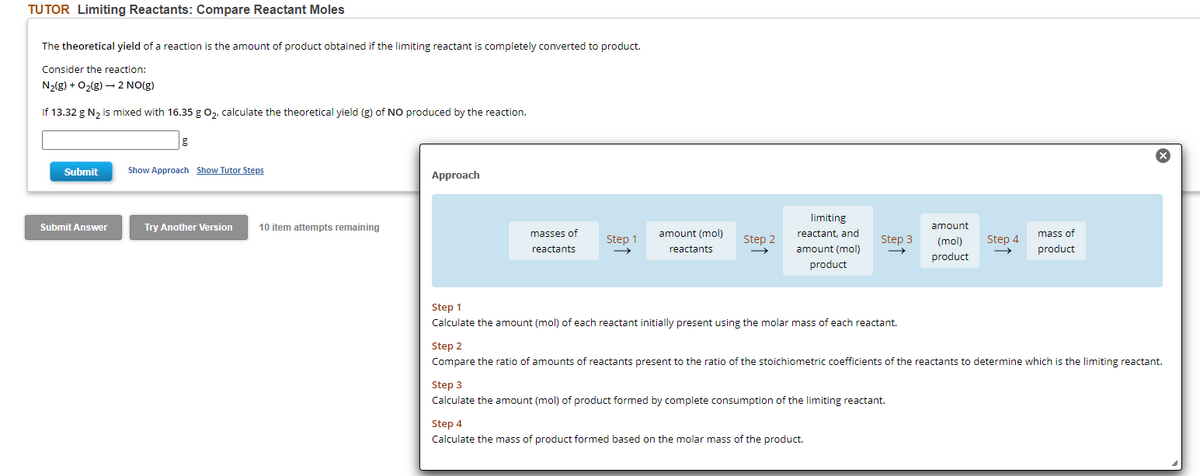The theoretical yield of a reaction is the amount of product obtained if the limiting reactant is completely converted to product. Consider the reaction: N₂(g) + O₂(g) 2 NO(g) If 13.32 g N₂ is mixed with 16.35 g O₂, calculate the theoretical yield (g) of NO produced by the reaction. Submit Submit Answer Show Approach Show Tutor Steps Try Another Version 10 item attempts remaining Approach masses of reactants Step 1 amount (mol) reactants Step 2 limiting reactant, and amount (mol) product Step 3 Step 1 Calculate the amount (mol) of each reactant initially present using the molar mass of each reactant. Step 4 Calculate the mass of product formed based on the molar mass of the product. amount (mol) product Step 4 mass of product Ⓡ Step 2 Compare the ratio of amounts of reactants present to the ratio of the stoichiometric coefficients of the reactants to determine which is the limiting reactant. Step 3 Calculate the amount (mol) of product formed by complete consumption of the limiting reactant.
The theoretical yield of a reaction is the amount of product obtained if the limiting reactant is completely converted to product. Consider the reaction: N₂(g) + O₂(g) 2 NO(g) If 13.32 g N₂ is mixed with 16.35 g O₂, calculate the theoretical yield (g) of NO produced by the reaction. Submit Submit Answer Show Approach Show Tutor Steps Try Another Version 10 item attempts remaining Approach masses of reactants Step 1 amount (mol) reactants Step 2 limiting reactant, and amount (mol) product Step 3 Step 1 Calculate the amount (mol) of each reactant initially present using the molar mass of each reactant. Step 4 Calculate the mass of product formed based on the molar mass of the product. amount (mol) product Step 4 mass of product Ⓡ Step 2 Compare the ratio of amounts of reactants present to the ratio of the stoichiometric coefficients of the reactants to determine which is the limiting reactant. Step 3 Calculate the amount (mol) of product formed by complete consumption of the limiting reactant.
Chemistry: The Molecular Science
5th Edition
ISBN:9781285199047
Author:John W. Moore, Conrad L. Stanitski
Publisher:John W. Moore, Conrad L. Stanitski
Chapter3: Chemical Reactions
Section: Chapter Questions
Problem 121QRT: Ammonia can be formed by a direct reaction of nitrogen and hydrogen. N2(g) + 3 H2(g) 2 NH3(g) A...
Related questions
Question

Transcribed Image Text:TUTOR Limiting Reactants: Compare Reactant Moles
The theoretical yield of a reaction is the amount of product obtained if the limiting reactant is completely converted to product.
Consider the reaction:
N₂(g) + O₂(g) → 2 NO(g)
If 13.32 g N₂ is mixed with 16.35 g 0₂, calculate the theoretical yield (g) of NO produced by the reaction.
Submit
Submit Answer
g
Show Approach Show Tutor Steps
Try Another Version 10 item attempts remaining
Approach
masses of
reactants
Step 1
amount (mol)
reactants
Step 2
limiting
reactant, and
amount (mol)
product
Step 3
Step 1
Calculate the amount (mol) of each reactant initially present using the molar mass of each reactant.
Step 4
Calculate the mass of product formed based on the molar mass of the product.
amount
(mol)
product
Step 4
mass of
product
Step 2
Compare the ratio of amounts of reactants present the ratio of the stoichiometric coefficients of the reactants to determine which is the limiting reactant.
Step 3
Calculate the amount (mol) of product formed by complete consumption of the limiting reactant.
Expert Solution
This question has been solved!
Explore an expertly crafted, step-by-step solution for a thorough understanding of key concepts.
Step by step
Solved in 4 steps

Knowledge Booster
Learn more about
Need a deep-dive on the concept behind this application? Look no further. Learn more about this topic, chemistry and related others by exploring similar questions and additional content below.Recommended textbooks for you

Chemistry: The Molecular Science
Chemistry
ISBN:
9781285199047
Author:
John W. Moore, Conrad L. Stanitski
Publisher:
Cengage Learning

Introductory Chemistry: A Foundation
Chemistry
ISBN:
9781337399425
Author:
Steven S. Zumdahl, Donald J. DeCoste
Publisher:
Cengage Learning

Chemistry for Engineering Students
Chemistry
ISBN:
9781285199023
Author:
Lawrence S. Brown, Tom Holme
Publisher:
Cengage Learning

Chemistry: The Molecular Science
Chemistry
ISBN:
9781285199047
Author:
John W. Moore, Conrad L. Stanitski
Publisher:
Cengage Learning

Introductory Chemistry: A Foundation
Chemistry
ISBN:
9781337399425
Author:
Steven S. Zumdahl, Donald J. DeCoste
Publisher:
Cengage Learning

Chemistry for Engineering Students
Chemistry
ISBN:
9781285199023
Author:
Lawrence S. Brown, Tom Holme
Publisher:
Cengage Learning


Chemistry
Chemistry
ISBN:
9781305957404
Author:
Steven S. Zumdahl, Susan A. Zumdahl, Donald J. DeCoste
Publisher:
Cengage Learning

Chemistry: An Atoms First Approach
Chemistry
ISBN:
9781305079243
Author:
Steven S. Zumdahl, Susan A. Zumdahl
Publisher:
Cengage Learning